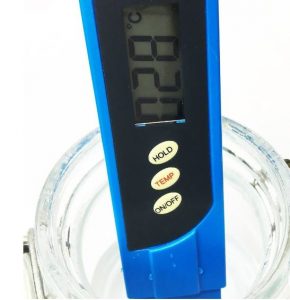What is TDS?
TDS refers to the Total Dissolved Solids that can be found in a liquid. The solids can be a variety of salts, minerals, metals, anions, and cations. When they are dissolved in a liquid, their weight can be measured using a TDS meter.
Measuring TDS
The most accurate way to measure TDS is to evaporate the liquid and weigh the solid particles that remain. This is not always practical, which is why a TDS meter is more commonly used to test for dissolved solids. A TDS meter provides a reading by measuring the conductivity of the dissolved ions in a solution. Once the reading is taken, a formula is used to convert it into an estimation of the TDS. The TDS reading can give you an indication of the quality of the water.
How a TDS Meter Works
Because the dissolved solids have an electrical charge, the TDS meter can measure the electrical conductivity. It does this by emitting a small electrical current that passes through the water. The meter then captures electrical conductivity, or EC and converts it into a TDS number. Some meters are designed to provide both the actual EC reading and the TDS value.
TDS Levels
The TDS levels found in water can indicate whether or not it contains contaminants. This doesn’t necessarily mean the water is unsafe, but it could be an indicator that further testing is needed. High TDS levels can be caused by hard water which is caused by a high mineral content. Low TDS levels are typically a result of filtration. Extremely low TDS levels could be problematic, however, as they are associated with corrosion.
TDS levels often vary depending on the area of the country in which you live. The higher levels of dissolved minerals in certain areas cause hard water, while other areas have lower levels. These lower levels can impact the pH, making the water more acidic and corrosive.
TDS in Drinking Water
The dissolved solids that are typically found in drinking water come from a number of sources. Many are natural and seep into water through the soil, but some come from pipes, sewage, and chemical run-off. The amount and type of solids in your water can affect the hardness and taste.
The EPA has labeled TDS as a secondary contaminant that has an aesthetic effect. These are contaminants that can cause the water to have an unpleasant look, taste, or smell, but they are not considered a health threat. The EPA has set the maximum contaminant level for TDS in drinking water at 500 parts per million, or 500mg/L. The noticeable effects when levels exceed that threshold include hardness, colored water, deposits, salty taste, and staining.
Using a TDS Meter
A TDS meter is the perfect tool to test drinking water, aquariums, pools, spas, and hydroponics. A home-use TDS meter is a small battery-operated, hand-held device, about one inch by six inches. It has metal probes at one end that are covered by a protective cap when not in use. It’s best to test water that is at room temperature. To perform the test, remove the cap from the probes. Turn it on, dip it in the water, and wait until you get a reading. Compare your readings to the chart below:
| Level ot TDS (milligrams per liter) | Rating |
|---|---|
| Less than 300 | Excellent |
| 300 - 600 | Good |
| 600-900 | Fair |
| 900 - 1,200 | Poor |
| Above 1,200 | Unacceptable |
As you can see, the TDS levels give you an indication as to the quality of your water. This can be useful for maximizing the lifespan of water filters for drinking water, aquariums, and pools. Filters come with an estimation for replacement, but the TDS meter can show you exactly when they need to be changed.
What to Do About TDS
A high TDS reading simply means that there are particles in your water that could be affecting its smell and taste. The easiest solution to correct high TDS is to invest in a water filter. There are a variety of filters available from inexpensive, individual bottle filters, too much more expensive whole house systems. Remember, high TDS levels do not mean that your water is unsafe to drink, but investing in a TDS meter is an easy way to regularly monitor your water quality.
If you really want to know what is causing high TDS level, you can purchase a water testing kit that is designed to test for particular contaminants. This will give you more detailed information as to what is in your water and at what levels.



How to change batary
How long does it take to get a reading? My read out remains at 0.00.
I did mine with tap water and it’s
469 ppm
And 997 ps/cm
26.1 c
79.3 f
So what does mean
Good bad?